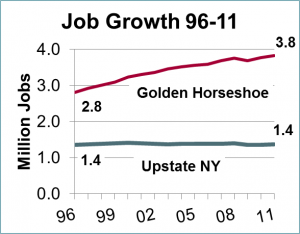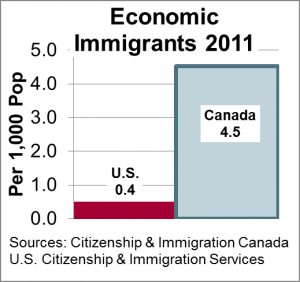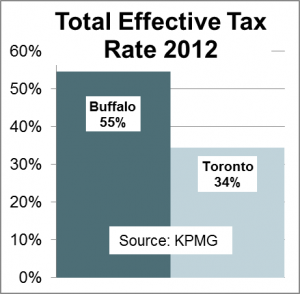 Remember the Fast Ferry connecting Rochester and Toronto? Although the idea failed in execution, connecting with the vibrant “Golden Horseshoe” economy made sense then—and still does today. When we compare Rochester to, say, Charlotte or Atlanta or Austin, we can always blame the snow. But that doesn’t work when we look across the lake. What’s their “secret sauce?”
Remember the Fast Ferry connecting Rochester and Toronto? Although the idea failed in execution, connecting with the vibrant “Golden Horseshoe” economy made sense then—and still does today. When we compare Rochester to, say, Charlotte or Atlanta or Austin, we can always blame the snow. But that doesn’t work when we look across the lake. What’s their “secret sauce?”
 We may be separated only by a bit of water and a line on a map, but it is clear that Canada’s Golden Horseshoe Region, powered by Toronto, has prospered while Upstate New York (defined here as Rochester, Buffalo and Syracuse) has just held its own. Although these neighboring regions share much—that climate, access to markets, and transportation infrastructure—since 1996 the Golden Horseshoe added more than a third to its employment base and a quarter to its population.
We may be separated only by a bit of water and a line on a map, but it is clear that Canada’s Golden Horseshoe Region, powered by Toronto, has prospered while Upstate New York (defined here as Rochester, Buffalo and Syracuse) has just held its own. Although these neighboring regions share much—that climate, access to markets, and transportation infrastructure—since 1996 the Golden Horseshoe added more than a third to its employment base and a quarter to its population.
 Upstate has increased neither. Among the many explanatory variables, two policy differences stand out: Immigration and business taxes.
Upstate has increased neither. Among the many explanatory variables, two policy differences stand out: Immigration and business taxes.
Give us your smart, your skilled . . .
Canadian voters and politicians understand that immigration is good for their economy. Adjusted for population, immigration to Canada in 2011 was more than twice that of the United States.
 As the endless debate over immigration reform in Washington makes abundantly clear, we’re much more ambivalent about the subject here in the U.S. Immigration, even if it was a formative force in the creation of our nation and culture, is still a mixed blessing. Yet economists largely agree that immigrants contribute more than they take. And some immigrants contribute much more.
As the endless debate over immigration reform in Washington makes abundantly clear, we’re much more ambivalent about the subject here in the U.S. Immigration, even if it was a formative force in the creation of our nation and culture, is still a mixed blessing. Yet economists largely agree that immigrants contribute more than they take. And some immigrants contribute much more.
The Canadians admit relatively more immigrants overall, but they also give preferential treatment to “economic immigrants,” individuals who bring skill and education to their adopted workplace. Although the United States also grants preference to the skilled and educated, the quota is far smaller. In fact, in 2011 Canada admitted nearly 17,000 more immigrants on economic grounds than the United States, despite the tenfold difference in population. The rate of economic immigration to Canada was 4.5 per thousand residents v. 0.4 in the United States.
The Rochester region attracts many foreign nationals to our large and respected higher education community. Not only is this good for our higher education marketplace—which is a major industry in the Finger Lakes—but it also brings talent from around the globe to our community. Let’s make it easier for them to stay after they’ve gotten an advanced degree from the University of Rochester or Rochester Institute of Technology. These bright, ambitious people have much to contribute.
Tax burden matters
 Canada also boasts a favorable tax climate for business. The burden of taxation on business is not the only factor driving a firm’s decision to locate in one locale or another, but it can be an important tipping factor. According to a study released by consultancy KPMG in 2012[*], the best tax climate for business overall was India. Ranked second was Canada, just ahead of China. Surprised? I’ve long assumed that the tax burden in Ontario was more onerous than it is here in New York.
Canada also boasts a favorable tax climate for business. The burden of taxation on business is not the only factor driving a firm’s decision to locate in one locale or another, but it can be an important tipping factor. According to a study released by consultancy KPMG in 2012[*], the best tax climate for business overall was India. Ranked second was Canada, just ahead of China. Surprised? I’ve long assumed that the tax burden in Ontario was more onerous than it is here in New York.
Yet in a head-to-head competition between Buffalo and Toronto (Rochester wasn’t included in the study), KPMG reports that business taxes in Toronto are two-thirds of Buffalo’s. Taxation isn’t the only factor influencing business location—if it were, New York City would be a ghost town. Nonetheless, the tax burden can tip the business location decision, assuming all other factors are comparable. KPMG’s study tells us that from a business location perspective, Toronto has a better story to tell. Remember, too, that businesses in Ontario don’t provide health care insurance, as do most big businesses here in New York.
What can we learn from Toronto?
Although many other factors are at work here, the Golden Horseshoe’s formula includes a welcoming immigration policy and a favorable tax climate. And from the perspective of Upstate New York, it appears to be working.
What are the lessons for New York and the United States?
First, our ability to tax business is limited. The rhetorical battle over tax policy often focuses on what individuals and firms can afford to pay. As much as this may appeal to our sense of fairness, experience tells us that taxes affect behavior. Individuals and business firms are willing and able to take action to avoid or reduce taxation, including relocation.
Second, immigrants revitalize our economy; they don’t threaten it. The stars are aligned for immigration reform. As Congress struggles with reform of the nation’s immigration laws, it should expand access to the best and brightest of other nations. The colleges and universities of the United States, including the many highly respected institutions located in Upstate New York, are the world’s most powerful magnet for smart young people from foreign lands. Some have suggested that a graduate diploma should automatically come with the right to work, that valuable “green card.” Not only would this improve the nation’s economy, it would help Upstate New York emulate the success of its neighbor to the north.